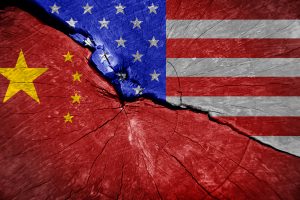A small nation in the Baltic with a GDP of $56 billion, Lithuania has provoked the ire of the People’s Republic of China (PRC) recently by allowing Taiwan to open a de facto embassy in the country. This, in addition to asking its officials to abandon Chinese-made cell phones over censorship allegations and its departure from a PRC-led regional forum, has touched on Beijing’s geopolitical redlines. Beijing has responded with punitive economic measures. The PRC has downgraded its ties with Lithuania, blocked Lithuanian exports (though recently they were unblocked), and threatened retaliation for multinational companies that did not sever ties with the Baltic country. Is it puzzling that Beijing’s economic coercion on Vilnius seems needlessly aggressive and alienating? Well, it shouldn’t be.
As we demonstrate in a new report released by the Center for a New American Security (CNAS), the PRC has been ramping up the use of coercive economic measures in the last few years, as coercive economic statecraft has become a more crucial component of its general foreign policy. It has an expansive toolkit of coercive tools, which cuts across economic and political domains and often includes both official and more off-book measures. Off-book coercive economic actions include targeted actions that press on economic interests of specific entities and typically fall outside the realm of official policies, such as boycotts encouraged through state propaganda. Smaller economies and those that are deeply integrated with the PRC economy may be most vulnerable, but the companies and citizens of major economies, including the United States, have also been targets.
To date, the United States and its allies have struggled to respond quickly or effectively to the PRC’s tactics, though recently Western governments have shown more political willingness to call out the PRC’s coercive behavior. There are more steps that the United States must take to sharpen its coercive economic statecraft on the PRC and come to the aid of partner nations. This requires a rethinking of U.S. coercive economic statecraft.
Using an innovative set of scenario exercises, based on wargaming best practices, the CNAS research team found that the PRC is the most willing to deploy the widest range of economic tools in response to a geopolitical conflict. The United States may be hampered in its response, due to divergent economic interests with its closest allies and differing views on the strategic threat to liberal democracies that is posed by China. At the same time, the United States must find a way to leverage its alliances so that the combined economic heft of nations pushing back on China’s economic coercion is persuasive to Beijing.
Recognizing these complex dynamics, the CNAS research team developed strategic concepts to guide U.S. coercive economic statecraft. First, the United States should deploy joint pressure with allies and partners to ensure maximal impact of coercive economic policy on the PRC. Notably, this strategic concept does not rule out unilateral U.S. action, but emphasizes the importance of prioritizing coordinated approaches to ensure maximal deterrence effects. We strongly recommend that the United States design and conduct joint economic scenario exercises with partner nations to enhance joint economic strategic planning.
Second, the United States should have a strategy of bound engagement in which it engages in economic escalation in a manner that is bound by constraints embodied in domestic and international rules and norms. The United States benefits from a stable global economy, and thus its actions should serve to reinforce rather than undermine stability and predictability, while also providing a credible deterrent to further economic coercion. One way to demonstrate commitment to bound engagement is to signal clearly to partner and competitor nations that the U.S. would enforce international and bilateral economic rules. In this case of Lithuania, the United States should consider making statements (ideally, joint statements with European stakeholders) that condemn Chinese coercive actions, support litigation in the WTO if applicable, and provide countervailing economic support to Lithuania in order to both raise the cost to the PRC of using coercive economic tactics while blunting the negative economic impacts on their target.
The United States and its partners must also consider developing new tools. The EU’s proposed anti-coercion instrument represents an interesting effort on this front. It also demonstrates the potential pitfalls of a stronger lean towards coercive economic statecraft globally, as it may in part be in response to U.S. actions that negatively impacted Europe and underscores the risks of unilateral actions. Deploying coercive economic statecraft following the strategic concepts of joint pressure and bound engagement represents a path forward to responsibly manage a fraught geopolitical environment and reassert the U.S. role in promoting a stable, rules-based economic order.
































